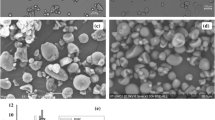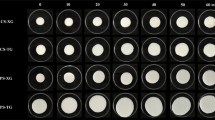Abstract
Durian (Durio zibethinus Murr.) seed flour (DSF) has very soft gel with high syneresis. Blending it with cassava starch (CS) could deliver strongly advantageous effects. The objective of this work was to investigate the functional and physicochemical properties of blends of CS and DSF. Experimentally, commercial cassava starch CS (18.18 ± 0.11% amylose) was blended with DSF (containing 55.44 ± 4.93% gum and 14.62 ± 0.07% amylose) in various CS/DSF ratios: 100/0, 90/10, 80/20, 70/30, 60/40, 50/50, 40/60, 30/70, 20/80, 10/90, and 0/100 by dry weight. The key properties of those blends were investigated, namely swelling power (SP), solubility, pasting properties by the Rapid Visco Analyzer (RVA), gelatinization temperature, and gel texture and syneresis. CS showed lower SP at 60 °C, but higher SP at 75 and 90 °C than DSF, while DSF had higher solubility than CS at all temperatures tested. The blends had SP and solubility between these extremes. RVA viscosities for all ratios of the CS/DSF blends were often below those of the individual components, with DSF influencing more than expected from its proportion. The peak viscosity (PV) of CS was significantly higher than that of DSF (3955 ± 37 vs. 1918 ± 17 mPa.s). The PV of CS/DSF blends with 10/90–60/40 ratios was slightly different from that of DSF, but increased strongly for the 70/30- 90/10 ratios. As regards gelatinization, CS had lower temperature range (62.66 ± 0.13–72.06 ± 0.21 °C,) than DSF (67.50 ± 0.55–79.35 ± 0.16 °C), while its enthalpy was higher (12.83 ± 0.81 vs. 5.38 ± 0.16 J/g). All the blends showed higher gelatinization temperature than CS but lower than DSF and their enthalpies had the opposite trend. Regarding the gel properties, gel hardness of CS was about five-fold higher than that of DSF (50.9 ± 30.27 vs. 9.59 ± 0.67, p < 0.05), while syneresis of CS was much lower (1.61 ± 0.33 vs. 58.30 ± 0.44%, p < 0.05) than of DSF. For their blends, it turned out that gel hardness increased and syneresis decreased with CS content in the blend. The gel hardness was synergistic for 90/10 and 80/20 ratios with about 50% increase over the pure components, and simultaneously the syneresis relative to plain DSF was reduced by over 50%. The results suggested that improved DSF properties can be achieved by blending with CS, and also a small amount of DSF (10–20%) has synergistic effect on gel hardness of the blend. Gum in the DSF plays an important role in the continuous phase of the paste and the gel.




Similar content being viewed by others
References
A.M. Amin, A.S. Ahmad, Y.Y. Yin, N. Yahya, N. Ibrahim, Food Hydrocoll. 21(2), 273–279 (2007)
M. Belgis, C.H. Wijaya, A. Apriyantono, B. Kusbiantoro, N.D. Yuliana, Int. Food Res. J. 23(4), 1466–1473 (2016)
B.T. Amid, H. Mirhosseini, Food Biophys. 7(4), 317–328 (2012)
B.T. Amid, H. Mirhosseini, Food Chem. 132, 1258–1268 (2012)
B.T. Amid, H. Mirhosseini, Carbohydr. Polym. 90(1), 452–461 (2012)
B.T. Amid, H. Mirhosseini, S. Kostadinović, Chem. Cent. J. 6(1), 117 (2012)
A.M. Amin, R. Arshad, Int. J. Post. Tech. Innov. 1(4), 367–375 (2009)
S. Baraheng, T. Karrila, Food Biosci. (2019). https://doi.org/10.1016/j.fbio.2019.100412
M. Chaisawang, M. Suphantharika, Food Hydrocoll. 20(5), 641–649 (2006)
J. Waterschoot, S.V. Gomand, E. Fierens, J.A. Delcour, Starch-Stärke 67(1–2), 1–13 (2015)
L.B. Karam, M.V.E. Grossmann, R.S.S.F. Silva, C. Ferrero, N.E. Zaritzky, Starch/Stärke 57(2), 62–70 (2005)
N.J. Tonukari, Electron. J. Biotechnol. 7(1), 5–6 (2004)
A.J. Gunorubon, D.K. Kekpugile, Int. J. Eng. Technol. 2(6), 913–919 (2012)
Y. Yao, J. Zhang, J.X. Ding, J. Food Sci. 68, 260–265 (2003)
M. Obanni, J.N. BeMiller, Cereal Chem. 74, 431–436 (1997)
V. Sae-kang, M. Suphantharika, Carbohydr. Polym. 65, 371–380 (2006)
J. Muadklay, S. Charoenrein, Food Hydrocoll. 22, 1268–1272 (2008)
H.-M. Chen, X. Fu, Z.-G. Luo, Food Hydrocoll. 51, 355–360 (2015)
T. Temsiripong, R. Pongsawatmanit, S. Ikeda, K. Nishinari, Food Hydrocoll. 19, 1054–1063 (2005)
P. Hongsprabhas, K. Israkarn, C. Rattanawattanaprakit, Carbohydr. Polym. 67, 614–622 (2007)
R. Pongsawatmanit, S. Srijunthongsiri, J. Food Eng. 88(1), 137–143 (2008)
M. Sikora, S. Kowalski, P. Tomasik, Food Hydrocoll. 22, 943–952 (2008)
C.-H. Chen, W.-S. Kuo, L.-S. Lai, Food Hydrocoll. 23, 2132–2140 (2009)
S. Shanavas, S.N. Moorthy, M.S. Sajeev, R.S. Misra, A.S. Sundazeem, Trends Carbohydr. Res. 2, 11–22 (2010)
N.J. BeMiller, Carbohydr. Polym. 86, 386–423 (2011)
K. Mahmood, H. Kamilah, P.L. Shang, S. Sulaiman, F. Ariffin, A.K. Alias, Food Biosci. 19, 110–120 (2017)
T. Tongdang, Starch/Stärke 60(3–4), 199–207 (2008)
B.V. McCleary, T.S. Gibson, D.C. Mugford, J. AOAC Int. 80, 571–579 (1997)
AOAC, Official Methods of Analysis. 950.46 (AOAC Press, Washington, DC, 2000)
T.S. Gibson, V.A. Solah, B.V.A. McCleary, J. Cereal Sci. 25(2), 111–119 (2007)
Y. Takeda, S. Hizukuri, C. Takeda, A. Suzuki, Carbohydr. Res. 165, 139–145 (1987)
N. Singh, J. Singh, L. Kaur, N.S. Sodhi, B.S. Gill, Food Chem. 81, 219–231 (2003)
J.Y. Li, A.I. Yeh, J. Food Eng. 50(3), 141–148 (2001)
X. Kong, J. Bao, H. Corke, Food Chem. 113, 371–376 (2009)
L. Wang, B. Xie, J. Shi, J. Xue, Q. Deng, Y. Wei, B. Tian, Food Hydrocoll. 24, 208–216 (2010)
M. A. Razali, F. Abd Hakim, A A. Ngelambong, N. A. Zakaria, H. K. R. Khan, H. K. R. Proceedings of the Asia-Euro Conference, (Subang Jaya, Malaysia, November 24-26, 2010)
M. Cornelia, T. Siratantri, R. Prawita, Proc. Food Sci. 3, 1–18 (2015)
M. Alloncle, J.L. Doublier, Food Hydrocoll. 5, 455–467 (1991)
A.M. Hermansson, K. Svegmark, Trends Food Sci. Technol. 71, 345–353 (1996)
W.A. Atwell, L.F. Hood, D.R. Lineback, E.V. Marston, H.F. Zobel, Cereal Foods World 33, 306–311 (1988)
T.E. Leite, J.F. Nicoleti, A.L.B. Penna, C.M.L. Frannco, Ciênc. Tecnol. Aliment. 32(3), 579–587 (2012)
S. Satrapai, M. Suphantharika, Carbohydr. Polym. 67, 500–510 (2007)
S. Khanna, R.F. Tester, Food Hydrocoll. 20, 567–576 (2006)
A.A. Karim, M.H. Norziah, C.C. Seow, Food Chem. 71, 9–36 (2000)
Acknowledgements
This research was funded by the Halal Food Science Center, Department of Food Science and Nutrition, Faculty of Science and Technology, Prince of Songkla University, Pattani Campus, (SAT581365S) and Graduate school Prince of Songkla University, Thailand.
Author information
Authors and Affiliations
Corresponding author
Ethics declarations
Conflict of interest
The authors declare that having they have no conflict of interest.
Additional information
Publisher's Note
Springer Nature remains neutral with regard to jurisdictional claims in published maps and institutional affiliations.
Electronic supplementary material
Below is the link to the electronic supplementary material.
Rights and permissions
About this article
Cite this article
Leemud, P., Karrila, S., Kaewmanee, T. et al. Functional and physicochemical properties of Durian seed flour blended with cassava starch. Food Measure 14, 388–400 (2020). https://doi.org/10.1007/s11694-019-00301-6
Received:
Accepted:
Published:
Issue Date:
DOI: https://doi.org/10.1007/s11694-019-00301-6




